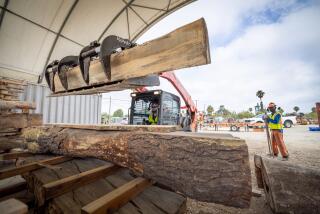Making Greenbacks Greener : Companies Hope Recycling Old Cash Into New Products Pays
People have always dreamed about having enough money to burn.
Thatâs why Ace Noffsinger, general manager of Log World in Coachella, is trying to manufacture and sell cordwood logs made out of old greenbacks.
Log World is one of five Southern California companies negotiating with the Federal Reserve Bank in Los Angeles to recycle 1,100 tons a year of shredded U.S. currency into products ranging from roof shingles to freeway sound barriers.
âWeâre trying to find a source that will take this and recycle it so we donât have to fill up the landfills,â said Brent Duxbury, an administrator with the Federal Reserve in Los Angeles. âIt costs us about $60,000 a year to get rid of it, including disposal fees and transportation fees.â
The bank will give the stuff--which looks like green confetti packed into briquettes--to any company willing to haul it away on a regular basis. Duxbury said the bank plans to decide by mid-August which company or companies will get the money.
Stationery maker Crane & Co., based in Dalton, Mass., pioneered the idea last year when it began making pale green note pads and envelopes out of shredded dollars and marketing them under the name Old Money.
In addition to the novelty of making things out of used dollars, manufacturers say the linen fibers in bills make their products stronger. They also enjoy helping the environment by utilizing a material that would otherwise go into a landfill.
Every year, the Fed pulls 7 billion bills--weighing 7,000 tons--out of circulation that are limp, dirty, torn or generally unfit, said John Cameron, a spokesman for the Fed in Washington. Each week, the bank in Los Angeles disposes of three 15-by-8-by-7-foot trash bins containing old bills, Duxbury said.
Log Worldâs Noffsinger said the shredded currency should blend easily into his Everglo pressed logs. He said he hopes to start production by early August.
âWe take construction waste and all different things that are going to the dumps and we recycle it and grind it,â he said. To that, the company adds paper and a small amount of resin and then presses the material into log shapes for use in campfires or fireplaces, he said.
Log World uses 12,000 pounds of paper to make about 10,000 logs a day and could easily use as much of the shredded money as the Fed will give away, Noffsinger said.
Gridcore Systems International has been experimenting with the shredded bills in its Long Beach factory, adding them to the mixture of corrugated cardboard and office paper that go into the companyâs molded fiber panels, company President Robert Noble said.
âItâs a nice color, like marble,â Noble said. âWe added more white paper to the mix with the currency to create the marble effect.â
Gridcore panels--which are usually beige and are available in a variety of thicknesses--are used in stage sets and trade show exhibits and as ceiling tiles.
Already, an Encinitas, Calif., company has installed 500 square feet of the Gridcore panels for a floral exhibit at the Los Angeles County Fair, which will open in September, said James Wilkinson, president of Environscape Productions.
âYou can see where the little shreds of money are in it,â said Wilkinson, who was attracted to the panelâs look and texture. âPeople will get a kick out of it.â
Cal Shake in Irwindale and Terra Roofing in Fontana are making fireproof roofing shingles with the shredded currency.
Matthew Philippe, vice president of operations at Cal Shake, said the material works fine as a replacement for cardboard in his companyâs shingle mixture. Terra Roofingâs moneyed shingles are still being tested for strength and flexibility, Executive Vice President Lawrence Grossman said.
But both companies said it may not be cost-effective for them to transport, store and process the shredded money, even though they can have it for free.
âThe real question is, can we justify the cost of equipment to handle the shredded confetti versus the baled cardboard?â Philippe said.
The answer will depend on the volatile price of cardboard, which has doubled in the last six months. Using the old money âwould insulate us from wild swings in the price of cardboard,â he said.
Richard Artzer, owner of Monolithic Building Systems in Oceanside, Calif., said he is prepared to use the shredded money as a replacement for the expanded polystyrene--which looks like Styrofoam--that goes inside the walls and freeway sound barriers his company builds.
The walls are made with four inches of shredded currency wrapped in a plastic tube and sandwiched between an inch of concrete. They are heavier than the walls made with expanded polystyrene and absorb more sound, Artzer said.
âIf I can get filler for nothing, then itâs worth it to use it,â Artzer said. âIt keeps the cost of my product down, and I can pass that savings along to my customers.â
Artzer builds about 20 miles of walls a year, though there is only enough shredded money to fill half of them, he said. Still, he is optimistic the currency will help boost his sales.
âI can say my walls are worth a lot of money,â Artzer said. âItâs a good selling point.â
More to Read
Inside the business of entertainment
The Wide Shot brings you news, analysis and insights on everything from streaming wars to production â and what it all means for the future.
You may occasionally receive promotional content from the Los Angeles Times.







